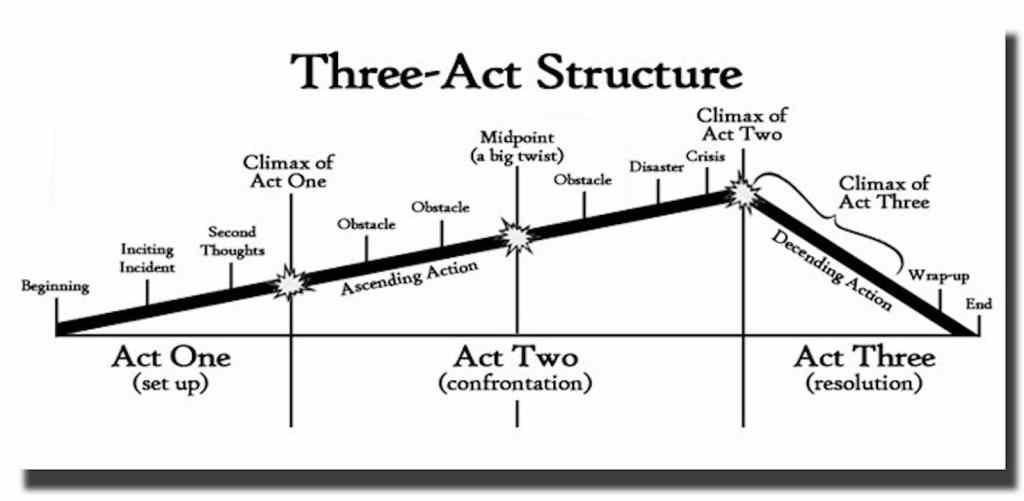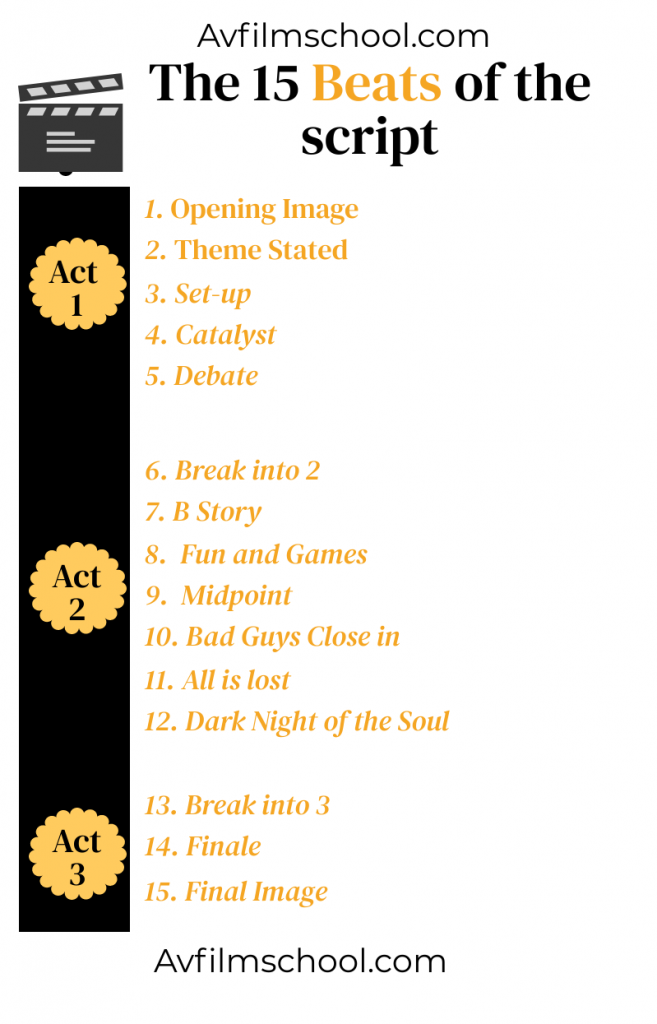This blog post is highlighting my research area of my MAJOR PROJECT. For this blog post, I will be looking into and reflecting on the different types of Story Structures for which I will be researching to start planning my MAJOR PROJECT – a feature-length script. Overall, I will be researching and reflecting upon SEVEN structures (some overlap) that are held high amongst Scriptwriting ‘Guru’s’. Instead of ending with a case study, I will be ending with reflecting upon which I believe may be useful to my MAJOR PROJECT and deciding on one to take forward to start my script structure.
It was recommended by my MAJOR PROJECT mentor, Sam Snape (Screenwriter) to pick one story structure to start planning my feature length script. He advised to research various structures and then choose one to start off with.
The 7 different people’s structure’s I have chosen are:
Three Act Structure (Aristotle)
Three Act Structure ‘Paradigm’ (Syd Field)
Three Act Structure ‘Central Point’ (Robert McKee)
15 Point Beat Sheet (Blake Synder)
22 Building Blocks (John Truby)
Hero’s Journey (Campbell)
Hero’s Journey (Vogler)
Aristotle, Syd Field and Robert McKee – The Three Act Structure
ARISTOTLE
Let’s go right back at the start. Greek philosopher, Aristotle, is credited as being the person who created the Three Act Structure. In chapter 6, in his book, Poetics (Aristotle & Sachs, 2011) he looks into the importance of tragedy within stories and comments that ‘for tragedy is an imitation not of people but of actions and life’ (2011:27). The ‘Three Act Structure’ – pictured below.

Simply put, this structure looks to three parts of one story – Beginning, Middle and End.
SYD FIELD
Syd Field refers to his Three Act Structure as a ‘Paradigm’ – image of structure below:

Personally, I felt like Field’s book was quite an easy read due to the ease of his writing – he makes it simple to understand and interesting with examples.
Syd Field in his book: Screenplay (Field, 2005) explores the Three Act Structure looking at it as a SEQUENCE. He describes this as ‘a series of scenes connected by one single idea with a definite beginning, middle, and end’ (Field, 2005:103) and this makes Field’s structure a relatively straight forward to structure one’s screenplay. Beginning, Middle and End. That’s all you need to start as ‘it is the skeleton, or backbone, of your script and, like the nature of structure itself, holds everything together’ (Field, 2005:103). Field’s structure provides enough detail to structure one’s screenplay with enough detail to give the writer a good starting point but I think personally that a structure with some more detail (possibly Synder or Truby – will be discussed below) may be more useful to me than Field’s structure. Although I do agree with Field as he comments:
‘when you begin writing your screenplay, you need to know four things: the opening, the Plot Point at the end of Act I, the Plot Point at the end of Act II, and the ending. When you know what those four elements are, and have done the necessary preparation on action and character, then you’re ready to start writing’ (Field, 2005:105)
ROBERT MCKEE
Much like the previous two:
McKee’s Three Act Structure is called the ‘Central Plot’.
McKee’s Three Act Structure is slightly different but follows the three parts to the story. The only difference is that the ‘Inciting Incident’ is before Act 1 starts – pictured below in Figure 3.

McKee’s structure is a very simple structure and I feel this would be used a literal way of telling your audience the beginning, middle and end without having to go into much detail.
BLAKE SNYDER
Save the Cat (Snyder, 2005) has been a personal favourite screenwriting book of mine for the past four years when it was first introduced to me when I started university.
I find Snyder’s way of writing – much like Field (above) – easy to read and not a chore to read. Snyder makes his book interesting and a joy to read.

Snyder’s 15 Beat Sheet Structure uses the Three Act Structure as the basis.
Beats 1-5 are in ACT 1
Beats 6-12 are in ACT 2
Beats 13-15 are in ACT 3
I think that this creates an easier way to structure the story with the mix of the Three Acts and the individual ‘Beats’.
JOHN TRUBY
Personally, I feel like Truby’s 22 steps is a more in-depth version of the Todorov’s Equilibrium Theory.
Todorov looks to have a ‘minimal complete plot can be seen as a shift from one equilibrium to another’ (Todorov & Weinstein, 1969:75). The starting equilibrium and the ending equilibrium of a story are ‘similar and different, are separated by a period of imbalance, which is composed of a process of degeneration and a process of improvement’ (Todorov & Weinstein, 1969:75). Truby’s 22nd Building Block is a “New Equilibrium” – just like Todorov’s theory. The development of the protagonist and the story in between the first and last step help to shape and form what the “New Equilibrium” will be.

As someone who procrastinates too much, I personally find Truby’s structure too much. Personally, I’m worried Truby’s 22 step structure being too intricate for myself, even though Truby makes a point that not all the steps need to be used for every story.
CAMPBELL’s HERO’s JOURNEY and VOGLER Hero’s Journey

An example of the Hero’s Journey in a film is Star Wars IV: A New Hope (1977). Michael Lee from The Script Lab delivers a solid example of how Star Wars follows this structure and also uses clips from the film to demonstrate his point. He goes with Vogler’s 12 points that break down the structure:
- ‘The Ordinary World: We see the hero’s normal life at the start of the story before the adventure begins.
- Call to Adventure: The hero is faced with an event, conflict, problem, or challenge that makes them begin their adventure.
- Refusal of the Call: The hero initially refuses the adventure because of hesitation, fears, insecurity, or any other number of issues.
- Meeting the Mentor: The hero encounters a mentor that can give them advice, wisdom, information, or items that ready them for the journey ahead.
- Crossing the Threshold: The hero leaves their ordinary world for the first time and crosses the threshold into adventure.
- Tests, Allies, and Enemies: The hero learns the rules of the new world and endures tests, meets friends, and comes face-to-face with enemies.
- The Approach: The initial plan to take on the central conflict begins, but setbacks occur that cause the hero to try a new approach or adopt new ideas.
- The Ordeal: Things go wrong and added conflict is introduced. The hero experiences more difficult hurdles and obstacles, some of which may lead to a life crisis.
- The Reward: After surviving The Ordeal, the hero seizes the sword — a reward that they’ve earned that allows them to take on the biggest conflict. It may be a physical item or piece of knowledge or wisdom that will help them persevere.
- The Road Back: The hero sees the light at the end of the tunnel, but they are about to face even more tests and challenges.
- The Resurrection: The climax. The hero faces a final test, using everything they have learned to take on the conflict once and for all.
- The Return: The hero brings their knowledge or the “elixir” back to the ordinary world.’
(The Script Lab, 2019)

Personally, I think the Hero’s Journey makes one’s script have to follow a certain path – which could make one’s script constrained to a certain type of story.
I do however like Vogler’s character archetypes:
- The Hero
- The Mentor
- The Threshold Guardian
- The Herald
- The Shapeshifter
- The Shadow
- The Ally
- The Trickster
I will keep these in mind when developing my characters.
MY PERSONAL REFLECTION OF THE DIFFERENT STRUCTURES:
Three Act Structure (Aristotle, Syd Field & Robert McKee)
- In short: Beginning, Middle and End.
- Inciting Incident
- Pinch Points
- Climax
- Ends with a Resolution
15 Point Beat Sheet (Blake Snyder)
- 15 Beats split into the three acts
22 Building Blocks (John Truby)
- A more complex version of Todorov’s Equilibrium Theory
- Like Three Act – Inciting Event is here
- Similarities to Hero’s Journey
Hero’s Journey (Campbell and Vogler)
- 12 Point Journey
- 8 Character Archetypes (Vogler)
DECISION:
I have decided to use Blake Snyder’s Beat Sheet as a starting point to start planning my MAJOR PROJECT of a feature-length script. I believe that this structure is the best for me at this starting point due to the way Snyder presents his 15 beats in three parts and the structure is simple enough but enough parts for me to develop my script fully to be able to start writing.
Reflection about not choosing the other structures:
I found with the Three Act Structure (Aristotle, Field and McKee) was almost too simple and not detailed enough for me to write a structure which I would be fully happy to start writing afterwards. Although Field’s idea of nailing ‘the opening, the Plot Point at the end of Act I, the Plot Point at the end of Act II, and the ending’ (Field, 2005:105) is a very important thing to do.
Truby’s 22 Building Blocks was the opposite of the Three Act Structure. I found that I would over complicate things by using Truby’s structure. However,
The Hero’s Journey – although a favourite of mine for a while due to Star Wars – is almost too structured in a sense. I felt myself finding it restrictive and having to stay within the boundaries of what both Campbell and Vogler say must happen within the Hero’s Journey.
Bibliography:
Aristotle & Sachs, J. (2011) Poetics. [Online] Massachusetts: Focus Publishing/R. Pullins Co. Available from: https://ebookcentral.proquest.com/lib/herts/detail.action?docID=998514# [Accessed: 26th November 2021]
CAMPBELL, J. (2008). The hero with a thousand faces. 3rd Ed. San Franscico: New World Library.
FIELD, S. (2005). Screenplay: the foundations of screenwriting. [Online] London: Delta. Available from: https://www.vlebooks.com/Product/Index/2164571?page=0 [Accessed: 12th November 2021]
LEE, M. (2019). The Hero’s Journey Breakdown: Star Wars. The Script Lab. [Online] 11th October. Available from: https://thescriptlab.com/features/screenwriting-101/12309-the-heros-journey-breakdown-star-wars/ [Accessed: 2nd January 2022]
MCKEE, R. (1999). Story: Substance, Structure, Style, and the principle of screenwriting. London: Methuen.
SNYDER, B. (2005). Save the cat: the last book on screenwriting you’ll ever need. Studio City: Michael Wiese Productions.
TODOROV, T. & WEINSTEIN, A. (1969). ‘Structural Analysis of Narrative’. A Forum of Fiction. [Online] 3(1) pp.70-76. Available from: https://www.jstor.org/stable/1345003?seq=1#metadata_info_tab_contents [Accessed: 17th December 2021]
TRUBY, J. (2008). The Anatomy of Story: 22 Steps to Becoming a Master Storyteller. US: Farrar, Straus and Giroux.
VOGLER, C. (2007). The Writer’s Journey: Mythic Structure for writers. 3rd Ed. Studio City: Michael Wiese Productions.
Filmography:
Star Wars: Episode IV – A New Hope. (1977). Film. Directed by George Lucas. [DVD]. US: 20th Century Fox.
Illustrations:
Figure 1: 3 Act Structure
Figure 2: Syd Field
Figure 3: Robert McKee
Figure 4: Save the Cat
Figure 5: John Truby
Figure 6: Hero’s journey
Figure 7: Vogler